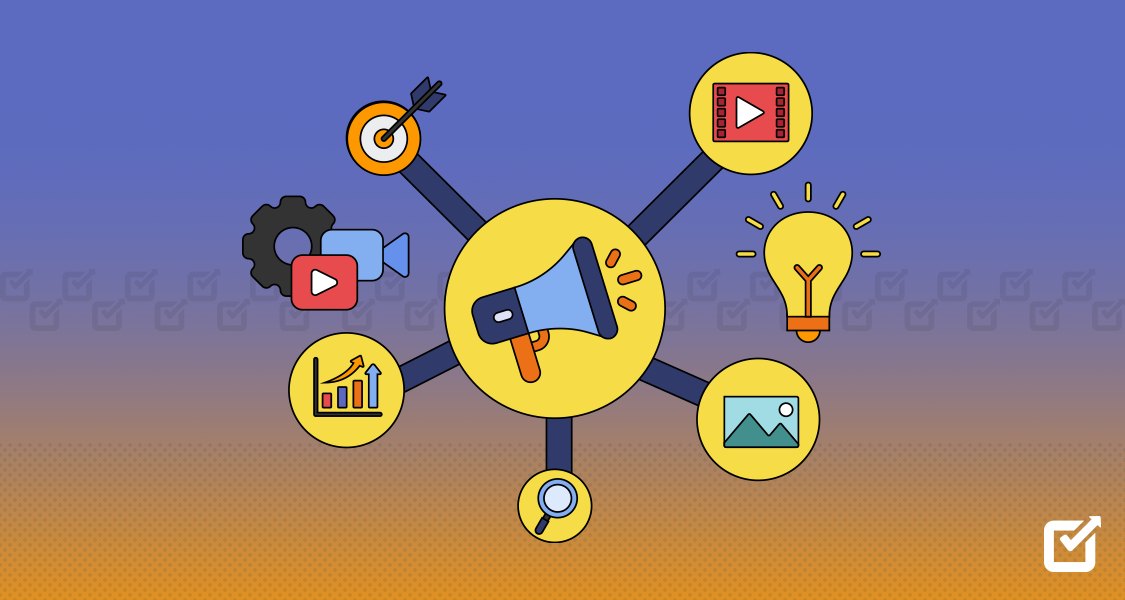Ever wondered why some marketing campaigns take off while others barely catch anyone’s eye?
The secret lies in strategic social media campaign planning.
With billions of active users worldwide, it’s no wonder that 92% of marketers say social media is important for their business.
If you’re not capitalizing on this massive opportunity, you’re missing out.
A well-executed social media campaign can be all the difference between business success and obscurity.
All you need is a combination of strategic planning, innovative tactics, and using advanced social media management tools.
So are you ready to take your social media campaigns to the next level in 2024?
This guide will equip you with the knowledge and strategies to create campaigns that not only grab attention but also drive results.
Let’s get started!

Plan Your Campaigns With Ease!
Schedule posts, track mentions, review analytics, and engage your audience with Social Champ! Maximize your impact today!
Short Summary
- A social media campaign is a targeted marketing effort on social media that aims to achieve specific goals, such as boosting brand awareness or driving sales.
- Social media campaign planning involves defining objectives, understanding and analyzing the target audience, and choosing the right platforms and content formats.
- Social media campaign planning has many benefits, including optimizing conversion rates, telling your brand story, establishing thought leadership, gaining a competitive edge, improving brand perception, expanding global reach, and measuring success for continuous improvement.
- Developing a content strategy involves defining objectives, identifying the target audience, creating content plans, and selecting the right social media platforms.
- Crafting compelling content and scheduling it effectively is key to a successful campaign, and tools like Social Champ can streamline this process.
- Implementing and monitoring the campaign involves launching content, tracking performance, and analyzing results to refine strategies and improve future campaigns.
- Effective social media campaign planning helps build strong audience connections, achieve marketing goals, and drive brand growth.
What Is Social Media Campaign Planning
A social media campaign is a focused marketing effort on social media to achieve a specific goal, like boosting brand awareness or driving sales.
It involves creating and sharing a series of content with a clear start and end date.
When we talk about social media campaign planning, we’re discussing the whole process of figuring out how you’re going to use social media to achieve your goal.
It involves several key steps, including:
- Defining clear objectives, such as increasing brand awareness, driving website traffic, or boosting sales.
Understanding these goals helps shape the campaign’s direction and ensures that all efforts are aligned with your overall business objectives.
- Next, planning includes identifying and analyzing your target audience.
This involves researching preferences, behaviors, and the social media platforms they frequently use.
- The planning phase also involves selecting the right social media platforms and content formats that will best reach and engage your audience.
This includes deciding on the types of posts, such as images, videos, or infographics, and scheduling them for optimal times to maximize visibility.
Featured Article: 16+ Best Free Social Media Management Tools Every Marketer Should Know
Benefits of Social Media Campaign Planning
Social media campaign planning offers numerous benefits that can significantly enhance the effectiveness of your marketing efforts.
Here are some key advantages:
Conversion Rate Optimizations
A well-planned social media campaign helps optimize conversion rates by targeting specific audience segments with tailored messaging.
Analyzing data and adjusting strategies in real-time can enhance the effectiveness of your calls to action and refine your approach to better meet customer needs.
This results in higher conversion rates and improved overall campaign performance.
Tell Your Brand Story
Social media campaigns offer a platform to craft and share your brand’s narrative, connecting with your audience on a deeper level.
Through consistent and engaging content, you can showcase your brand’s values, mission, and unique selling points.
This storytelling helps build emotional connections, fostering brand loyalty and recognition among your target audience.

An example of Lululemon setting its brand narrative via Instagram Become a Thought Leader
Strategic social media planning positions your brand as an industry thought leader by consistently sharing valuable insights, trends, and expertise.
You can establish your brand as a trusted authority by engaging with relevant topics and participating in industry discussions.
This enhances your credibility and attracts an audience that values your opinions and insights.
Competitive Advantage
Effective social media campaign planning gives you a competitive edge by analyzing market trends and competitor strategies.
You can develop unique approaches that set your brand apart by identifying gaps and opportunities.
This proactive strategy lets you stay ahead of competitors and capture market share through innovative and compelling campaigns.
Improve Your Brand’s Perception
A well-executed social media campaign can significantly enhance your brand’s image and reputation.
You build a positive perception among your audience through consistent messaging, high-quality content, and responsive customer service.
These continuous improvement efforts reflect positively on your brand, increasing trust and customer satisfaction.
Global Reach
Social media campaigns have the power to reach a global audience, breaking down geographical barriers.
By using targeted advertising and multilingual content, you can expand your brand’s visibility and connect with diverse markets.
This global reach opens up new opportunities for growth and international brand recognition.
Measurement and Evaluation
When you regularly analyze performance data, you can assess the effectiveness of your campaigns and make informed decisions.
This ongoing evaluation allows for continuous improvement and ensures that your strategies are aligned with your business goals.
Earn Greater ROI
Strategic planning and execution of social media campaigns lead to a higher return on investment (ROI).
By focusing on cost-effective advertising, optimizing ad spend, and targeting the right audience, you maximize the impact of your budget.
This efficient use of resources results in better financial outcomes and increased profitability.
Boost Website Traffic
Social media campaigns drive traffic to your website by promoting engaging content and compelling calls to action.
Strategically placing links and utilizing social media advertising, helps you direct users to your site, increasing traffic and potential conversions.
This boost in website visits contributes to higher search engine rankings and overall online visibility.
Featured Article: 10 Hottest Content Marketing Trends That Will Rule the Industry in 2025
Developing a Content Strategy and Choosing the Right Platforms
Creating a successful social media presence begins with a well-thought-out content strategy and the strategic selection of platforms.
A good content strategy defines your brand’s objectives, targets the right audience, and outlines a clear plan for engaging and impactful content.
Creating a Content Plan
A well-structured content plan is the cornerstone of an effective content strategy.
- Start by defining your goals and objectives, such as increasing brand awareness, generating leads, or driving sales.
- Next, identify your target audience, including their demographics, interests, and online behavior.
- Based on this information, develop content themes and topics that resonate with your audience and align with your brand’s values.
- Establish a content calendar to schedule posts consistently and ensure a steady stream of engaging content.
- Additionally, integrate key performance indicators (KPIs) to measure the success of your content and make data-driven adjustments.
Choosing the Right Social Media Platforms
Selecting the appropriate social media platforms is crucial for reaching your target audience effectively.
- Begin by evaluating each platform’s user demographics and features to determine which aligns best with your content goals.
For example, LinkedIn is ideal for B2B content and professional networking, while Instagram and TikTok cater to visual and entertainment-focused content.
- Consider the nature of your content—videos, infographics, articles—and choose platforms that support and enhance this format.
- Additionally, assess your team’s capacity for managing multiple platforms and focus on those where you can maintain a consistent and high-quality presence.
Tailoring Content for Each Platform
Customizing content for each platform ensures it resonates more effectively with the audience and achieves better results.
- Once you’ve selected the right platforms, tailor your content to fit each one’s specific requirements and audience preferences.For instance, high-quality visuals and short, engaging captions can be used on Instagram, while long-form articles and professional insights can be used on LinkedIn.
- Adapt your messaging to the platform’s tone and style, and utilize platform-specific features like Instagram Stories or Pinterest boards to maximize engagement.
Integrating Content Types and Formats
A diverse content mix keeps your audience engaged and interested.
- Incorporate various content types such as blog posts, infographics, videos, and podcasts to cater to different preferences and increase your reach.
- Plan to integrate these formats within your content strategy to maintain variety and appeal.
For example, you might use infographics to summarize blog posts or create short videos highlighting key points.
This approach not only enhances engagement but also provides multiple touchpoints for audience interaction.
Monitoring and Adjusting the Strategy
Effective content strategies require ongoing monitoring and adjustments.
- Regularly review performance metrics such as engagement rates, click-through rates, and conversions to evaluate the success of your content and platform choices.
- Use analytics tools to gather insights and identify trends or areas for improvement.
- Adjust your content plan and platform strategy to optimize results based on this data.
- Continuous evaluation ensures your content remains relevant and impactful, adapting to changing audience needs and preferences.
Featured Article: The Simplest Content Curation Guide to Boost Your Marketing Strategy
Creating Engaging Content and Scheduling Your Campaign
Once your content strategy is planned out, the next step is to create content for your campaign.
Crafting Compelling Content
Creating engaging content is essential for capturing your audience’s attention and driving interaction.
Start by understanding your audience’s interests, needs, and preferences.
Use this insight to craft content that resonates with them and addresses their pain points or desires.
Understanding Your Audience
- Know your audience: Identify their interests, pain points, and preferred content formats.
- Create buyer personas: Develop detailed profiles of your ideal customer to tailor your content accordingly.
Content Planning and Creation
- Define content pillars: Determine the main themes and topics that align with your brand.
- Create a content calendar: Plan your content to maintain consistency and variety.
- Mix up content formats: To keep your audience engaged, use a combination of text, images, videos, and infographics.
- Use user-generated content: Share posts from satisfied customers to build trust and authenticity.
Scheduling Your Campaign
Once you’ve created compelling content, scheduling it effectively is crucial to ensure consistency and maximize reach.
Utilizing scheduling tools like Social Champ can streamline this process.
Social Champ helps you manage and automate the posting process. It also helps create, schedule, and analyze your strategy.
Additionally, the tool offers several AI tools, including the AI-powered best time to post that tells you when to post for maximum engagement.

Social Champ’s best time to post tool You can also upload content in bulk and add RSS links to keep a steady flow of content on your socials.
Social Champ also offers social listening, to help you explore what is being said about your campaign.
This reduces the manual effort required and maintains a consistent posting schedule, which is essential for audience engagement and brand visibility.

Master Your Social Media Campaigns with Social Champ!
Our AI-powered platform helps you create engaging content, reach your target audience, and track your campaign’s success.
Implementing, Monitoring, and Analyzing Your Campaign
With everything in place, it’s time to launch your campaign.
Here’s a step-by-step guide to ensure a smooth rollout:
Launching Your Social Media Campaign
This step requires implementing your finalized social media campaign plan. In this phase, consider following these steps:
- Finalize Content: Review and finalize all content—text, images, videos, and any other media—to ensure alignment with your brand’s voice and campaign goals.
- Schedule Posts: Use scheduling tools like Social Champ to plan your posts. Set specific dates and times for each piece of content to ensure consistency and maximize reach. Take advantage of optimal posting times based on your audience’s online activity.
- Double-Check Settings: Verify all campaign settings on each platform, including ad targeting options, post visibility settings, and any promotional features you plan to use.
- Launch Your Campaign: Activate your campaign according to your content calendar. Monitor the initial rollout to address any immediate issues that might arise.
- Promote and Engage: If needed, actively promote your campaign through additional channels, such as email newsletters, website banners, or cross-promotion on other social media accounts. Engage with your audience by responding to comments, messages, and interactions promptly.
Tracking Performance
Monitoring performance helps you determine the success of your campaign and make necessary adjustments.
Here’s how to do it effectively:
- Set Up Analytics Tools: Ensure you have the necessary analytics tools set up on each platform. Social Champ, Google Analytics, and native platform insights can provide valuable data.
- Monitor Key Metrics: Keep an eye on key performance indicators (KPIs) that align with your campaign goals. Common metrics to track include:
- Engagement Rates: Likes, comments, shares, and overall interaction with your content.
- Click-Through Rates (CTR): The percentage of users who click on your links compared to those who see your posts.
- Conversion Rates: The percentage of users who complete a desired action (like making a purchase or signing up) after interacting with your content.
- Reach and Impressions: The total number of people who see your content and the frequency of views.
- Track Social Signals: Monitor social signals such as mentions, hashtags, and user-generated content related to your campaign. This can provide insight into how your campaign is being received and discussed.
- Review Engagement Patterns: Look for patterns in engagement—what times of day or types of content generate the most interaction? This can help optimize future posts and campaigns.
Analyzing Results
After your campaign has been running for a while, it’s time to analyze the results to gauge its success and identify areas for improvement:
- Collect Data: Gather all relevant data from your analytics tools. Compile performance metrics, social signals, and audience feedback.

Social Champ’s analytics - Evaluate Against Goals: Compare your results to the initial goals you set. Did you achieve your objectives, such as increased brand awareness, higher engagement, or more conversions?
- Identify Trends and Insights: Look for trends in your data. What types of content performed best? Were there particular platforms or times that yielded better results?
- Assess ROI: Calculate your campaign’s return on investment (ROI). Determine whether the resources spent (time, money, effort) delivered a worthwhile return on your goals.
- Gather Feedback: Collect feedback from your team and your audience. What did they think of the campaign? Were there any unexpected issues or positive surprises?
- Document Learnings: Document the key takeaways and insights from the campaign. What worked well, and what could be improved next time?
- Adjust Strategy: Use your analysis to refine your content strategy and approach for future campaigns. Implement changes based on what you’ve learned to enhance your effectiveness.
- Collect Data: Gather all relevant data from your analytics tools. Compile performance metrics, social signals, and audience feedback.
Conclusion
Effective social media campaign planning is crucial for standing out in a crowded digital landscape.
Optimizing your social media efforts requires developing a well-thought-out content strategy.
This includes choosing the right platforms, creating engaging content, and using tools like Social Champ for scheduling and monitoring.
Implementing, monitoring, and analyzing your campaigns ensures continuous improvement and maximizes your return on investment.
With these strategies, you can build strong connections with your audience, achieve your marketing goals, and drive significant growth for your brand.













